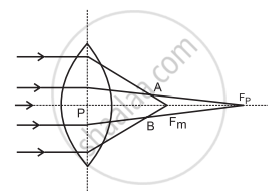Advertisements
Advertisements
प्रश्न
Answer the following question in detail.
Describe spherical aberration for spherical lenses. What are the different ways to minimize or eliminate it?
उत्तर
- All the formulae used for image formation by lenses are based on some assumptions. However, in reality, these assumptions are not always true.
- A single point focus in case of lenses is possible only for small aperture spherical lenses and for paraxial rays.
- The rays coming from a distant object farther from the principal axis no longer remain parallel to the axis. Thus, the focus gradually shifts towards the pole.
- This defect arises due to the spherical shape of the refracting surface, hence known as spherical aberration. It results in a blurred image with unclear boundaries.

Spherical aberration in convex lens
Spherical aberration in concave lens - As shown in the figure, the rays near the edge of the lens converge at focal point FM. Whereas, the rays near the principal axis converge at point FP. The distance between FM and FP is measured as the longitudinal spherical aberration.
- In absence of this aberration, a single point image can be obtained on a screen. In the presence of spherical aberration, the image is always a circle.
- At a particular location of the screen (across AB in the figure), the diameter of this circle is minimum. This is called the circle of least confusion. The radius of this circle is transverse spherical aberration.
Methods to eliminate/reduce spherical aberration in lenses:
- The cheapest method to reduce spherical aberration is to use a planoconvex or planoconcave lens with a curved side facing the incident rays.
- Certain ratio of radii of curvature for a given refractive index almost eliminates the spherical aberration. For n = 1.5, the ratio is `"R"_1/"R"_2=1/6` and n = 2, `"R"_1/"R"_2=1/5`.
- The use of two thin converging lenses separated by a distance equal to the difference between their focal lengths with the lens of larger focal length facing the incident rays considerably reduces spherical aberration
- Spherical aberration of a convex lens is positive (for real image), while that of a concave lens is negative. Thus, a suitable combination of them can completely eliminate spherical aberration.
APPEARS IN
संबंधित प्रश्न
Answer the following question.
Explain spherical aberration for spherical mirrors. How can it be minimized? Can it be eliminated by some curved mirrors?
Explain chromatic aberration for spherical lenses.
Answer the following question in detail.
What is achromatism? Derive a condition to achieve achromatism for a lens combination. State the conditions for it to be converging.
Answer the following question in detail.
Derive the expressions for the magnifying power and the length of a compound microscope using two convex lenses.
Refractive index of a flint glass varies from 1.60 to 1.66 for visible range. Radii of curvature of a thin convex lens are 10 cm and 15 cm. Calculate the chromatic aberration between extreme colours.
Refractive index of a flint glass varies from 1.60 to 1.66 for visible range. Radii of curvature of a thin convex lens are 10 cm and 12 cm. The chromatic aberration between extreme colours is ____________.
A convex lens of focal length 'f' is placed in contact with a concave lens of the same focal length. The equivalent focal length of the combination is ______.
Focal length of a convex lens will be minimum for ______.
The equiconvex lens has a focal length 'f'. If the lens is cut along the line perpendicular to principal axis and passing through the pole, what will be the focal length of any half part?
A glass slab of thickness 4 cm contains the same number of waves as in 'x' cm of water column when both are traversed by the same monochromatic light. If the refractive indices of glass and water for that light are `5/3` and `4/3` respectively, the value of x will be ______.
